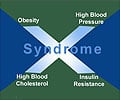Researchers have made advancement in the fight against metabolic syndrome and its associated atherosclerosis disorders, by identifying insulin resistance in the liver.
Researchers at the Joslin Diabetes Center have made advancement in the fight against metabolic syndrome and its associated atherosclerosis disorders, by identifying insulin resistance in the liver as a key factor in the cause of the condition.
According to the researchers their findings provide not only an understanding of how metabolic syndrome occurs, but also locate a target for treatment of the condition.This represents the work of Sudha Biddinger, M.D., Ph.D., and a team led by C. Ronald Kahn, M.D., Head of the Joslin Research Section on Obesity and Hormone Action and the Mary K. Iacocca Professor of Medicine at Harvard Medical School.
“This is one of the first true insights into the role of the liver in the metabolic syndrome and provides guidance for future therapies,’’ said senior investigator Dr. Kahn, an internationally recognized researcher in diabetes and metabolism.
“Showing this connection between atherosclerosis and insulin resistance is one of the most dramatic findings I’ve seen in 35 years,” he added.
Metabolic syndrome is a collection of medical problems related to insulin resistance, including obesity, glucose intolerance, hypertension, lowered HDL (“good”) cholesterol and elevated triglycerides. Together these are associated with an increased risk of atherosclerosis, the build-up of plaque in the coronary arteries that leads to heart attack and stroke.
The findings indicate that many of the most important features of the metabolic syndrome do have a common cause, thus challenging a joint position statement issued by the American Diabetes Association and the European Association for the Study of Diabetes that questioned the very existence of the metabolic syndrome.
Advertisement
“Rather, it appears that metabolic syndrome is truly a group of closely linked disturbances in glucose and cholesterol metabolism that stem from a defect in insulin signalling in the liver,” they added.
Advertisement
“The fact that one-fourth of American adults have the metabolic syndrome is alarming. The fact that large numbers of children are now being diagnosed with the metabolic syndrome is even more alarming,” said Biddinger.
To try and find out, the researchers engineered mice by “knocking out” -- i.e. genetically eliminating -- insulin receptors in the liver. From this one site of insulin resistance alone, these mice developed many of the lipid abnormalities associated with metabolic syndrome.
Furthermore, when fed a high-fat diet, the mice developed extremely high cholesterol, more than four times the levels found in normal mice fed the same diet. More importantly, all of the “knockout” mice developed atherosclerosis, while none of the normal mice did.
These findings “focus attention on the liver, since resistance in the liver is enough to cause these abnormalities. By pinpointing the liver, it gives researchers a target for developing potential clinical treatments, such as finding a way to overcome insulin resistance in the liver or to change the way the liver responds to insulin resistance,” the authors said.
Source-ANI
SRM/L











